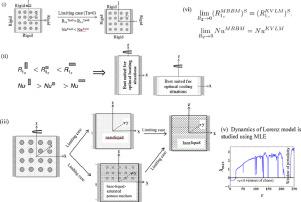当前位置:
X-MOL 学术
›
Int. J. Mech. Sci.
›
论文详情
Our official English website, www.x-mol.net, welcomes your
feedback! (Note: you will need to create a separate account there.)
STUDY OF ROTATING BÉNARD-BRINKMAN CONVECTION OF NEWTONIAN LIQUIDS AND NANOLIQUIDS IN ENCLOSURES
International Journal of Mechanical Sciences ( IF 7.1 ) Pub Date : 2020-12-01 , DOI: 10.1016/j.ijmecsci.2020.105931 K.M. Lakshmi , P.G. Siddheshwar , M.S. Muddamallappa
International Journal of Mechanical Sciences ( IF 7.1 ) Pub Date : 2020-12-01 , DOI: 10.1016/j.ijmecsci.2020.105931 K.M. Lakshmi , P.G. Siddheshwar , M.S. Muddamallappa

|
Abstract Taylor-Benard convection of water and water-based nanoliquids confined in three different types of high porosity rectangular enclosures, viz., shallow, square and tall, is studied analytically using both infinitesimal and finite amplitude stability analyses. We make use of the modified-Buongiorno-Brinkman model(MBBM) for the governing equations concerning nanoliquid-saturated porous enclosures bounded by rigid-rigid boundaries and obtain analytical results. Among three types of enclosures, maximum and minimum heat transfers are observed in tall and shallow enclosures respectively. Water well dispersed with a dilute concentration of single-walled carbon nanotubes(SWCNTs) is considered as a working medium. The water-SWCNTs is able to flow in the porous medium because the medium is loosely-packed with porosity in the range 0.5 ≤ ϕ ≤ 1. In addition to this, the maximum volume fraction of nanoparticles considered in the system is 6% and thus this does not alter the fluidity of the system. We found from the study that the presence of low concentration(volume fraction-0.06) of SWCNTs in a water-saturated porous medium effectively improves the heat transport of the system due to its high thermal conductivity and large surface area. Due to the presence of a porous medium, however, the onset of convection gets delayed and heat transport in nanoliquids gets substantially reduced in a Benard-Brinkman configuration resulting from the weak thermal conductivity of the porous medium. Thus the porous medium acts as the heat storage system. Also, in a rotating frame of reference the heat transport gets reduced and rotation serves as an external mechanism of regulating heat transport in the system. The nonlinear dynamics of the system is studied using the 6-mode Lorenz model. Chaotic motion in the system is studied using the maximum Lyapunov exponent(MLE). The Hofp-bifurcation point of the system along with the MLE is used to investigate periodic, nearly periodic and mildly chaotic behaviors of the system.
中文翻译:

外壳中牛顿液体和纳米液体的旋转 BÉNARD-BRINKMAN 对流研究
摘要 限制在三种不同类型的高孔隙率矩形外壳中的水和水基纳米液体的 Taylor-Benard 对流,即浅、方形和高,使用无穷小和有限振幅稳定性分析进行分析研究。我们利用修正的Buongiorno-Brinkman 模型(MBBM) 来求解关于以刚性-刚性边界为界的纳米液体饱和多孔外壳的控制方程,并获得分析结果。在三种类型的外壳中,分别在高和浅外壳中观察到最大和最小热传递。将稀释浓度的单壁碳纳米管 (SWCNT) 分散良好的水作为工作介质。水-单壁碳纳米管能够在多孔介质中流动,因为该介质是松散堆积的,孔隙率在 0.5 ≤ φ ≤ 1 范围内。除此之外,系统中考虑的纳米粒子的最大体积分数为 6%,因此这不会改变系统的流动性。我们从研究中发现,低浓度(体积分数-0.06)的单壁碳纳米管在水饱和多孔介质中的存在,由于其高热导率和大表面积,有效地改善了系统的传热。然而,由于多孔介质的存在,在贝纳德-布林克曼配置中,由于多孔介质的热导率较弱,对流的开始延迟并且纳米液体中的热传输显着减少。因此,多孔介质充当蓄热系统。还,在旋转参考系中,热传输减少,旋转作为调节系统热传输的外部机制。系统的非线性动力学研究使用 6 模式洛伦兹模型。使用最大李雅普诺夫指数(MLE)研究系统中的混沌运动。系统的 Hofp 分岔点与 MLE 一起用于研究系统的周期性、近周期性和轻度混沌行为。
更新日期:2020-12-01
中文翻译:

外壳中牛顿液体和纳米液体的旋转 BÉNARD-BRINKMAN 对流研究
摘要 限制在三种不同类型的高孔隙率矩形外壳中的水和水基纳米液体的 Taylor-Benard 对流,即浅、方形和高,使用无穷小和有限振幅稳定性分析进行分析研究。我们利用修正的Buongiorno-Brinkman 模型(MBBM) 来求解关于以刚性-刚性边界为界的纳米液体饱和多孔外壳的控制方程,并获得分析结果。在三种类型的外壳中,分别在高和浅外壳中观察到最大和最小热传递。将稀释浓度的单壁碳纳米管 (SWCNT) 分散良好的水作为工作介质。水-单壁碳纳米管能够在多孔介质中流动,因为该介质是松散堆积的,孔隙率在 0.5 ≤ φ ≤ 1 范围内。除此之外,系统中考虑的纳米粒子的最大体积分数为 6%,因此这不会改变系统的流动性。我们从研究中发现,低浓度(体积分数-0.06)的单壁碳纳米管在水饱和多孔介质中的存在,由于其高热导率和大表面积,有效地改善了系统的传热。然而,由于多孔介质的存在,在贝纳德-布林克曼配置中,由于多孔介质的热导率较弱,对流的开始延迟并且纳米液体中的热传输显着减少。因此,多孔介质充当蓄热系统。还,在旋转参考系中,热传输减少,旋转作为调节系统热传输的外部机制。系统的非线性动力学研究使用 6 模式洛伦兹模型。使用最大李雅普诺夫指数(MLE)研究系统中的混沌运动。系统的 Hofp 分岔点与 MLE 一起用于研究系统的周期性、近周期性和轻度混沌行为。











































 京公网安备 11010802027423号
京公网安备 11010802027423号